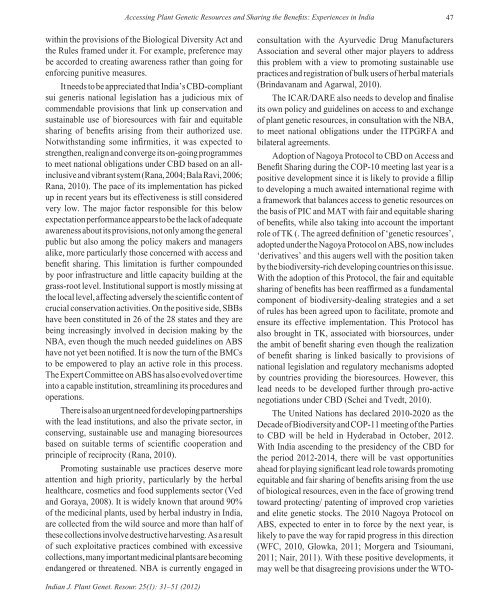indian society of plant genetic resources - Bioversity International
indian society of plant genetic resources - Bioversity International
indian society of plant genetic resources - Bioversity International
You also want an ePaper? Increase the reach of your titles
YUMPU automatically turns print PDFs into web optimized ePapers that Google loves.
Indian J. Plant Genet. Resour. 25(1): 31–51 (2012)<br />
Accessing Plant Genetic Resources and Sharing the Benefi ts: Experiences in India 47<br />
within the provisions <strong>of</strong> the Biological Diversity Act and<br />
the Rules framed under it. For example, preference may<br />
be accorded to creating awareness rather than going for<br />
enforcing punitive measures.<br />
It needs to be appreciated that India’s CBD-compliant<br />
sui generis national legislation has a judicious mix <strong>of</strong><br />
commendable provisions that link up conservation and<br />
sustainable use <strong>of</strong> bio<strong>resources</strong> with fair and equitable<br />
sharing <strong>of</strong> benefi ts arising from their authorized use.<br />
Notwithstanding some infi rmities, it was expected to<br />
strengthen, realign and converge its on-going programmes<br />
to meet national obligations under CBD based on an allinclusive<br />
and vibrant system (Rana, 2004; Bala Ravi, 2006;<br />
Rana, 2010). The pace <strong>of</strong> its implementation has picked<br />
up in recent years but its effectiveness is still considered<br />
very low. The major factor responsible for this below<br />
expectation performance appears to be the lack <strong>of</strong> adequate<br />
awareness about its provisions, not only among the general<br />
public but also among the policy makers and managers<br />
alike, more particularly those concerned with access and<br />
benefi t sharing. This limitation is further compounded<br />
by poor infrastructure and little capacity building at the<br />
grass-root level. Institutional support is mostly missing at<br />
the local level, affecting adversely the scientifi c content <strong>of</strong><br />
crucial conservation activities. On the positive side, SBBs<br />
have been constituted in 26 <strong>of</strong> the 28 states and they are<br />
being increasingly involved in decision making by the<br />
NBA, even though the much needed guidelines on ABS<br />
have not yet been notifi ed. It is now the turn <strong>of</strong> the BMCs<br />
to be empowered to play an active role in this process.<br />
The Expert Committee on ABS has also evolved over time<br />
into a capable institution, streamlining its procedures and<br />
operations.<br />
There is also an urgent need for developing partnerships<br />
with the lead institutions, and also the private sector, in<br />
conserving, sustainable use and managing bio<strong>resources</strong><br />
based on suitable terms <strong>of</strong> scientifi c cooperation and<br />
principle <strong>of</strong> reciprocity (Rana, 2010).<br />
Promoting sustainable use practices deserve more<br />
attention and high priority, particularly by the herbal<br />
healthcare, cosmetics and food supplements sector (Ved<br />
and Goraya, 2008). It is widely known that around 90%<br />
<strong>of</strong> the medicinal <strong>plant</strong>s, used by herbal industry in India,<br />
are collected from the wild source and more than half <strong>of</strong><br />
these collections involve destructive harvesting. As a result<br />
<strong>of</strong> such exploitative practices combined with excessive<br />
collections, many important medicinal <strong>plant</strong>s are becoming<br />
endangered or threatened. NBA is currently engaged in<br />
consultation with the Ayurvedic Drug Manufacturers<br />
Association and several other major players to address<br />
this problem with a view to promoting sustainable use<br />
practices and registration <strong>of</strong> bulk users <strong>of</strong> herbal materials<br />
(Brindavanam and Agarwal, 2010).<br />
The ICAR/DARE also needs to develop and fi nalise<br />
its own policy and guidelines on access to and exchange<br />
<strong>of</strong> <strong>plant</strong> <strong>genetic</strong> <strong>resources</strong>, in consultation with the NBA,<br />
to meet national obligations under the ITPGRFA and<br />
bilateral agreements.<br />
Adoption <strong>of</strong> Nagoya Protocol to CBD on Access and<br />
Benefi t Sharing during the COP-10 meeting last year is a<br />
positive development since it is likely to provide a fi llip<br />
to developing a much awaited international regime with<br />
a framework that balances access to <strong>genetic</strong> <strong>resources</strong> on<br />
the basis <strong>of</strong> PIC and MAT with fair and equitable sharing<br />
<strong>of</strong> benefi ts, while also taking into account the important<br />
role <strong>of</strong> TK (. The agreed defi nition <strong>of</strong> ‘<strong>genetic</strong> <strong>resources</strong>’,<br />
adopted under the Nagoya Protocol on ABS, now includes<br />
‘derivatives’ and this augers well with the position taken<br />
by the biodiversity-rich developing countries on this issue.<br />
With the adoption <strong>of</strong> this Protocol, the fair and equitable<br />
sharing <strong>of</strong> benefi ts has been reaffi rmed as a fundamental<br />
component <strong>of</strong> biodiversity-dealing strategies and a set<br />
<strong>of</strong> rules has been agreed upon to facilitate, promote and<br />
ensure its effective implementation. This Protocol has<br />
also brought in TK, associated with biorsources, under<br />
the ambit <strong>of</strong> benefi t sharing even though the realization<br />
<strong>of</strong> benefi t sharing is linked basically to provisions <strong>of</strong><br />
national legislation and regulatory mechanisms adopted<br />
by countries providing the bio<strong>resources</strong>. However, this<br />
lead needs to be developed further through pro-active<br />
negotiations under CBD (Schei and Tvedt, 2010).<br />
The United Nations has declared 2010-2020 as the<br />
Decade <strong>of</strong> Biodiversity and COP-11 meeting <strong>of</strong> the Parties<br />
to CBD will be held in Hyderabad in October, 2012.<br />
With India ascending to the presidency <strong>of</strong> the CBD for<br />
the period 2012-2014, there will be vast opportunities<br />
ahead for playing signifi cant lead role towards promoting<br />
equitable and fair sharing <strong>of</strong> benefi ts arising from the use<br />
<strong>of</strong> biological <strong>resources</strong>, even in the face <strong>of</strong> growing trend<br />
toward protecting/ patenting <strong>of</strong> improved crop varieties<br />
and elite <strong>genetic</strong> stocks. The 2010 Nagoya Protocol on<br />
ABS, expected to enter in to force by the next year, is<br />
likely to pave the way for rapid progress in this direction<br />
(WFC, 2010, Glowka, 2011; Morgera and Tsioumani,<br />
2011; Nair, 2011). With these positive developments, it<br />
may well be that disagreeing provisions under the WTO-

















